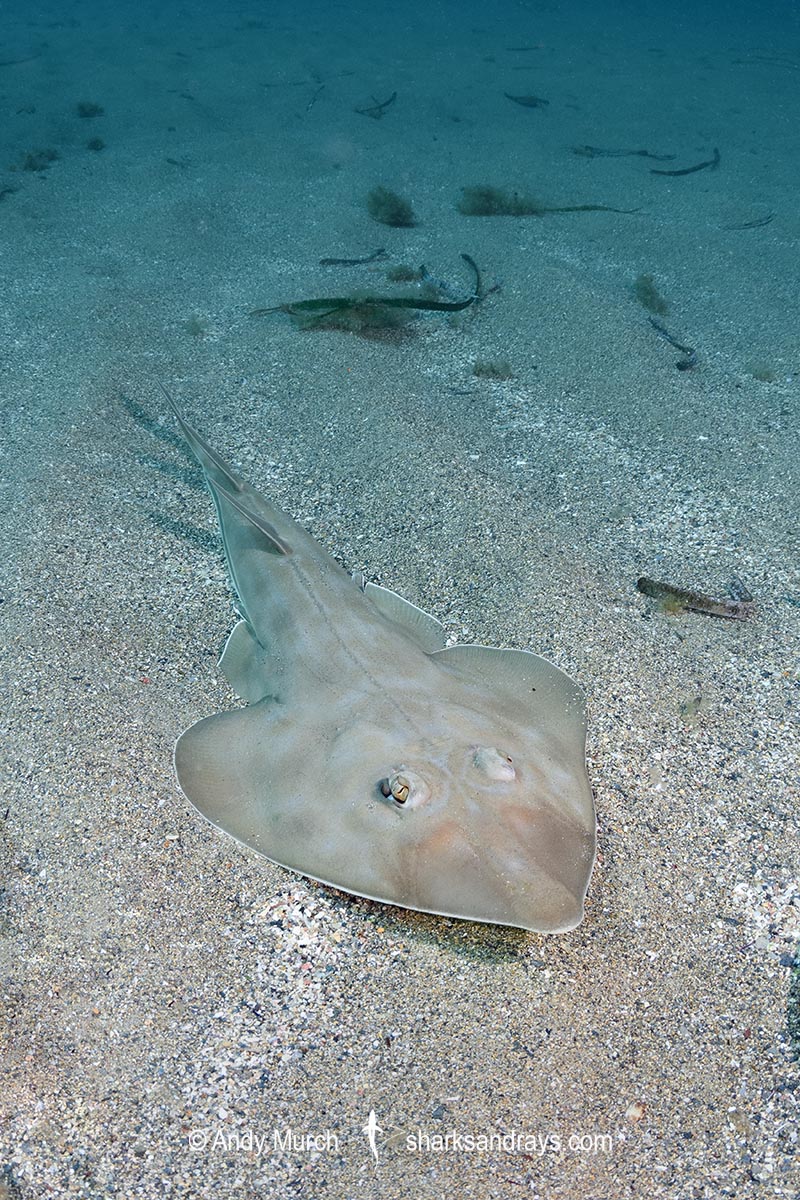Common name(s)
Common Guitarfish.
Binomial
Rhinobatos rhinobatos.
Synonyms
Leiobatus panduratus, Raia columnae, Raja rhinobatos, Rhinobathos rhinobathos, Rhinobatis duhameli, Rhinobatus columnae, Rhinobatus duhameli, Rhinobatus rhinobatus, Squatinoraja colonna.
Identification
A medium-sized guitarfish. Wedge-shaped snout lacking a protruding tip. Rostral ridges almost parallel, separated along their entire length, joining at snout tip. Eyes large. Preorbital length 3.2-3.8 x orbit length. Spiracles with 2 well developed posterior skin folds; inner fold smaller than outer. Nostrils positioned obliquely. Anterior nasal flaps extend into nostril opening.
Anterior margins of disc straight or weakly undulate. Pectoral apices rounded. Skin completely covered in small denticles. Small thorns around orbits, 2-3 on shoulders, and a continuous row along midline and tail to first dorsal base and between first and second dorsal.
Tail robust; 1.4-1.6 x disc length. Dorsal fins large and well separated, with acutely rounded apices. Caudal fin triangular, upper tip acute, posterior margin straight.
Colour
Dorsum yellowish-brown to reddish-brown, often with a diffuse pattern of longditudinal bluish stripes and blotches on torso and inner region of disc, and brighter diffuse yellow spots. Dorsal fins dusky. Well defined, dark brow V or X shape marking often present between eyes.
Size
Maximum length 100cm, possibly to 162cm. Size at birth ~25cm.

Conservation Status
CRITICALLY ENDANGERED
The Common Guitarfish (Rhinobatos rhinobatos) is caught as bycatch in trawl, long-line and gillnet fisheries throughout its range and is retained for it’s meat which is consumed locally, and for its fins which are exported to Asia.
Fishing pressure increased significantly in West Africa in the last few decades, probably leading to heavy declines, but historical catch records are not available for this area. Based on documented declines of other guitarfish species in the Central Eastern Atlantic, it is estimated that the common guitarfish has declined by around 80% in the last 30 years.

Habitat
Tropical/temperate seas. Benthic on soft sand and mud substrates, and sea grass beds. From close inshore to 180m.
Distribution
Eastern Atlantic. The common guitarfish occurs in the Atlantic from the Bay of Biscay to Angola, and throughout the Mediterranean Sea.
Reproduction
Aplacental viviparous. Litter size 0f 2-7 pups. Gestation period 10-12 months.
Diet
Benthic invertebrates (mainly crustaceans) and small fishes.
Behavior
Moves inshore at night to feed in shallow bays.
Reaction to divers
Fairly easy to approach during the day when found resting on the sand, but will swim away if approached too aggressively. Much easier to approach at night when actively foraging.
Diving logistics
The common guitarfish has become difficult to find throughout much of its range, but it is still relatively common in some bays in southern Spain including Cabo de Palos. Searching on open sand and sea grass beds should be successful in this area.
What’s new
View our full list of updates
Similar species
Spineback Guitarfish Display’s s similar V or X pattern between eyes, but distinguished by dorsal pattern of many small ocelli.




